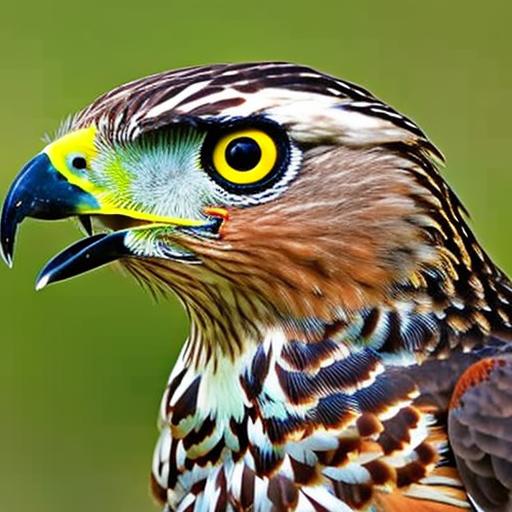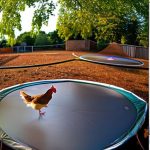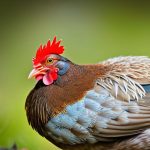Raising chickens can be a rewarding and fulfilling experience. Not only do they provide fresh eggs and meat, but they also make great pets and can be a source of entertainment. However, one of the challenges that chicken owners face is protecting their flock from predators, particularly hawks. Hawks are natural predators of chickens and can pose a significant threat to their safety. In this article, we will discuss the importance of protecting chickens from hawks and provide tips on how to do so effectively.
Key Takeaways
- Hawks target chickens as they are easy prey and provide a good source of food.
- Identifying common hawk species and their behavior can help in creating effective protective measures.
- Building a hawk-proof enclosure with chicken wire and other protective measures can keep chickens safe.
- Visual deterrents like scarecrows and reflective tape, as well as auditory deterrents like noise-making devices, can scare away hawks.
- Creating a distraction zone with trees and shrubs, providing shelter, and training chickens can also help protect them from hawks.
Understanding the Threat: Why Hawks Target Chickens
Hawks are attracted to chickens for several reasons. Firstly, chickens are relatively easy prey for hawks due to their size and vulnerability. Chickens are ground-dwelling birds and are not equipped with the ability to fly long distances or defend themselves against aerial attacks. This makes them an easy target for hawks, who can swoop down from above and snatch them up.
Secondly, hawks are opportunistic hunters and will take advantage of any available food source. Chickens provide a readily available source of food for hawks, making them an attractive target. Hawks have keen eyesight and can spot a chicken from high above, making it easy for them to locate potential prey.
Identifying Common Hawk Species and Their Behavior
There are several different species of hawks that may pose a threat to your chickens. It is important to be able to identify these species in order to understand their behavior patterns and develop effective strategies for protecting your flock.
One common hawk species is the Red-tailed Hawk. These hawks are large birds with broad wings and a distinctive red tail. They are known for their soaring flight patterns and can often be seen circling high above open fields or perched on telephone poles or trees.
Another common hawk species is the Cooper’s Hawk. These hawks are smaller than Red-tailed Hawks but are still formidable predators. They have a slender body and long tail, which helps them maneuver through dense vegetation. Cooper’s Hawks are known for their agility and speed, making them particularly dangerous to chickens.
Creating a Secure Chicken Coop: Tips for Building a Hawk-Proof Enclosure
| Aspect | Metric |
|---|---|
| Size | Minimum of 4 square feet per chicken |
| Height | At least 6 feet tall to prevent hawks from swooping in |
| Roof | Securely covered with wire mesh to prevent hawk attacks |
| Walls | Sturdy and made of materials that cannot be easily penetrated by predators |
| Door | Securely latched and made of strong materials to prevent predators from breaking in |
| Perches | Placed at least 2 feet off the ground to prevent predators from reaching them |
| Nesting boxes | Placed in a secure location and easily accessible for egg collection |
| Lighting | Provided to discourage predators from approaching at night |
| Cleanliness | Maintained regularly to prevent the buildup of waste and attract predators |
One of the most effective ways to protect your chickens from hawks is to create a secure chicken coop. A well-built coop will not only keep hawks out but will also provide a safe and comfortable environment for your flock.
When building a chicken coop, it is important to consider the size and strength of the hawks in your area. Hawks are powerful birds and can easily break through flimsy or poorly constructed enclosures. Use sturdy materials such as wood or metal to build the walls and roof of your coop, and reinforce any weak points with additional supports or hardware cloth.
It is also important to consider the height of your coop. Hawks are skilled fliers and can easily swoop down from above to snatch up a chicken. To prevent this, make sure your coop has a roof or cover that extends at least 2-3 feet above the top of the walls. This will make it more difficult for hawks to access your chickens.
Installing Chicken Wire and Other Protective Measures
In addition to building a secure coop, it is important to install chicken wire or other protective measures to keep hawks out. Chicken wire is a mesh material that is specifically designed to keep predators out while still allowing air and light to pass through.
When installing chicken wire, make sure it is securely attached to the walls and roof of your coop. Use heavy-duty staples or screws to ensure that it does not come loose or become damaged over time. It is also important to bury the bottom edge of the chicken wire at least 6 inches into the ground to prevent predators from digging underneath.
In addition to chicken wire, you may also want to consider installing netting or fencing around your coop to provide an extra layer of protection. Netting can be draped over the top of your coop to prevent hawks from swooping down, while fencing can be used to create a barrier around the perimeter of your coop.
Using Visual Deterrents: Scarecrows, Reflective Tape, and More

Visual deterrents can be an effective way to keep hawks away from your chickens. Hawks are wary birds and will often avoid areas that appear to be occupied or dangerous. By creating the illusion of a threat, you can discourage hawks from targeting your flock.
One popular visual deterrent is the scarecrow. Scarecrows are human-like figures that are placed in fields or gardens to scare away birds and other pests. The presence of a scarecrow can make hawks think twice before approaching your chickens, as they may mistake it for a potential threat.
Another visual deterrent is reflective tape or shiny objects. Hawks are attracted to movement and shiny objects can catch their attention and deter them from approaching. Hang strips of reflective tape or CDs from trees or posts near your coop to create a visual barrier that hawks will find intimidating.
Using Auditory Deterrents: Noise-Making Devices to Scare Away Hawks
In addition to visual deterrents, auditory deterrents can also be effective in keeping hawks away from your chickens. Hawks are sensitive to sound and will often avoid areas that are noisy or unfamiliar.
One option is to use noise-making devices such as alarms or whistles. These devices emit loud, high-pitched sounds that can startle hawks and discourage them from approaching. Place these devices near your coop or in trees surrounding your property to create a noisy environment that hawks will want to avoid.
Creating a Distraction Zone: Planting Trees and Shrubs to Distract Hawks
Creating a distraction zone can be an effective way to keep hawks away from your chickens. By planting trees and shrubs near your coop, you can create a natural barrier that hawks will be more likely to avoid.
Hawks prefer open areas where they can easily spot their prey. By planting trees and shrubs, you can create a more enclosed and protected environment for your chickens. This will make it more difficult for hawks to spot them and may discourage them from targeting your flock.
Providing Shelter: Encouraging Chickens to Hide from Hawks
Providing shelter for your chickens is an important part of protecting them from hawks. Chickens are naturally inclined to seek shelter when they sense danger, and providing them with a safe place to hide can help keep them safe.
One option is to provide your chickens with a covered run or outdoor enclosure. This will give them a protected space where they can roam freely without the risk of being snatched up by a hawk. Make sure the enclosure is secure and predator-proof, with a roof or cover that extends at least 2-3 feet above the top of the walls.
You can also provide additional hiding spots within your coop or run. Place large rocks, logs, or other objects that chickens can hide behind or under. This will give them a place to seek shelter if they sense danger and may deter hawks from targeting them.
Training Your Chickens: Teaching Them to Stay Safe from Hawks
Training your chickens to stay safe from hawks can be a valuable tool in protecting them. Chickens are intelligent animals and can learn to recognize and respond to potential threats.
One way to train your chickens is through positive reinforcement. Whenever you see a hawk or other predator in the area, make a loud noise or clap your hands to startle the chickens. This will teach them to associate the sound with danger and encourage them to seek shelter.
You can also train your chickens to respond to a specific command or signal. For example, you could teach them to come running to a specific spot in the coop or run when they hear a whistle or bell. This will help you quickly gather your flock and get them to safety if a hawk is spotted.
Working with Local Wildlife Officials: Understanding the Laws and Regulations for Protecting Your Flock
It is important to work with local wildlife officials to understand the laws and regulations for protecting your flock from hawks. Hawks are protected under federal law and it is illegal to harm or kill them without a permit.
Contact your local wildlife agency or department to learn more about the specific regulations in your area. They can provide guidance on how to legally protect your chickens from hawks and may be able to offer additional resources or support.
Protecting your chickens from hawks is an important part of being a responsible chicken owner. By understanding the threat that hawks pose and implementing effective strategies for protection, you can ensure the safety and well-being of your flock. From building a secure coop to using visual and auditory deterrents, there are many steps you can take to keep hawks away from your chickens. Remember to work with local wildlife officials to understand the laws and regulations in your area, and always prioritize the safety of your flock.
If you’re looking for ways to protect your chickens from hawks, you’ll definitely want to check out this informative article on how to keep hawks away from chickens. It provides practical tips and strategies to ensure the safety of your flock. From installing predator-proof fencing to using scare tactics, this article covers everything you need to know to keep your chickens safe from these aerial predators. Don’t miss out on this valuable resource!
FAQs
What are hawks?
Hawks are birds of prey that belong to the family Accipitridae. They are known for their sharp talons, hooked beaks, and keen eyesight.
Why do hawks attack chickens?
Hawks attack chickens because they are a source of food. Chickens are easy prey for hawks because they are slow-moving and cannot fly very high.
How can I keep hawks away from my chickens?
There are several ways to keep hawks away from your chickens, including using netting or wire mesh to cover your chicken coop, providing your chickens with hiding places, and using scare tactics like fake owls or reflective tape.
What are some natural predators of hawks?
Some natural predators of hawks include larger birds of prey like eagles and owls, as well as mammals like foxes and coyotes.
Are hawks protected by law?
Yes, hawks are protected by law in many countries, including the United States. It is illegal to harm or kill hawks without a permit.
Meet Walter, the feathered-friend fanatic of Florida! Nestled in the sunshine state, Walter struts through life with his feathered companions, clucking his way to happiness. With a coop that’s fancier than a five-star hotel, he’s the Don Juan of the chicken world. When he’s not teaching his hens to do the cha-cha, you’ll find him in a heated debate with his prized rooster, Sir Clucks-a-Lot. Walter’s poultry passion is no yolk; he’s the sunny-side-up guy you never knew you needed in your flock of friends!







